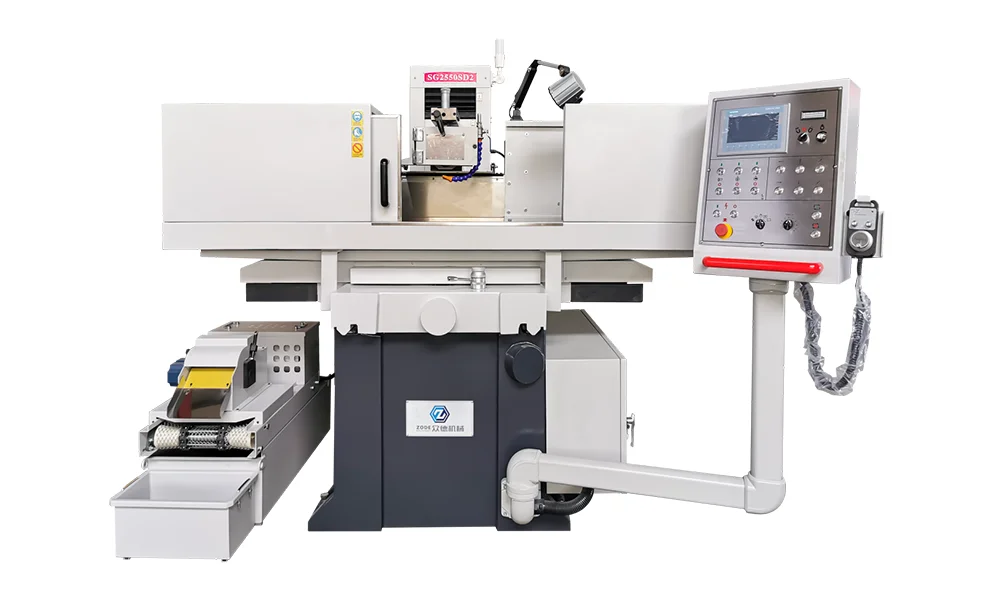- This topic is empty.
-
AuthorPosts
-
16/09/2025 at 11:10 #80169
Introduction to 2 Axis PLC Automatic Surface Grinder
The 2 axis PLC automatic surface grinder has emerged as a crucial piece of equipment in modern machining and manufacturing industries. Known for its efficiency, precision, and automation, this type of grinder integrates a programmable logic controller (PLC) system to control grinding operations with minimal manual intervention. Unlike conventional grinders, it ensures consistency, accuracy, and repeatability, making it a preferred choice in industries where high-quality surface finishing is non-negotiable. In this blog post, as one of the CNC surface grinding machine manufacturers, Nantong Zode will share the advantages of 2 axis PLC automatic surface grinder for precision manufacturing.
Why Choose PLC Controlled Surface Grinder?
At the heart of the 2 axis PLC surface grinder lies its control system. The PLC coordinates the vertical and cross-feed axes, enabling operators to program grinding cycles with great flexibility. This reduces human error while improving the efficiency of the grinding process. Manufacturers benefit from:
-
Automation of repetitive processes, minimizing operator fatigue.
-
Higher accuracy in achieving desired surface finishes.
-
Consistent results, critical for mass production environments.
-
Reduced setup time, since stored programs can be reused.
By blending automation with precision, the PLC-based grinder provides a competitive edge in machining operations.
Applications of 2 Axis PLC Automatic Surface Grinding Machine
The 2 axis automatic surface grinding machine finds wide use across different industrial sectors:
-
Tool and Die Manufacturing: For shaping molds and dies with exact dimensions.
-
Automotive Industry: Precision grinding of engine parts, transmission components, and braking systems.
-
Aerospace Industry: Achieving tight tolerances on turbine blades and structural parts.
-
Electronics and Semiconductor: Producing flat and smooth surfaces for micro-level components.
In all these applications, the demand for accuracy and repeatability makes the PLC surface grinder indispensable.
Advancements in Automatic Grinding Technology
Compared with older manual or semi-automatic grinders, the 2 axis PLC automatic surface grinder represents a leap forward in machining technology. Several advancements have been integrated into modern models:
-
Digital programming interfaces that allow easy input of grinding cycles.
-
Automatic lubrication systems for longer machine life and reduced maintenance.
-
High-rigidity spindle designs to minimize vibration and deliver superior surface quality.
-
Safety interlocks that protect operators while maximizing productivity.
These innovations make the equipment not just a tool, but a long-term investment in quality and efficiency.

Advantages of 2 Axis Automatic Surface Grinder in Precision Engineering
For industries where precision engineering is essential, the 2 axis automatic surface grinder offers measurable advantages:
-
Superior Surface Quality – Achieving mirror-like finishes with uniform flatness.
-
Time Efficiency – Automated cycles reduce machining time and increase throughput.
-
Cost Savings – Less material waste and reduced rework costs.
-
Flexibility – Capable of handling diverse materials including steel, cast iron, aluminum, and advanced composites.
-
Operator-Friendly – Intuitive controls and automated cycles reduce the skill barrier.
By leveraging these advantages, companies can improve operational efficiency and maintain competitiveness in global markets.
Integration of 2 Axis PLC Grinder into Smart Manufacturing
In the age of Industry 4.0, the PLC controlled surface grinder aligns perfectly with the concept of smart factories. The programmable logic controller allows seamless integration with other digital manufacturing systems. This ensures:
-
Data tracking of each grinding cycle for quality assurance.
-
Remote monitoring of machine status.
-
Predictive maintenance through sensor data, reducing downtime.
-
Scalability in production lines where flexibility and adaptability are critical.
This integration transforms the 2 axis automatic surface grinding machine into more than just equipment—it becomes a data-driven asset for modern manufacturing.
Comparing 2 Axis PLC Surface Grinder with Conventional Models
When evaluating the 2 axis PLC automatic surface grinder against conventional grinders, several distinctions stand out:
-
Manual Grinder – Requires skilled labor, prone to human errors, and offers limited repeatability.
-
Semi-Automatic Grinder – Reduces some manual work but lacks advanced programmability.
-
2 Axis PLC Automatic Grinder – Fully programmable, highly repeatable, and efficient in high-volume production.
For manufacturers looking to balance cost, efficiency, and long-term performance, the PLC-driven surface grinder clearly outperforms older technologies.
Future Trends in Surface Grinding Technology
Looking ahead, the 2 axis automatic surface grinder is expected to evolve further with advancements in automation, artificial intelligence, and material sciences. Possible future trends include:
-
AI-driven adaptive grinding cycles that adjust automatically to material variations.
-
Integration with robotic arms for complete automation of loading and unloading.
-
Eco-friendly grinding systems that reduce energy consumption and coolant waste.
-
Hybrid grinders combining multiple machining processes in one unit.
These developments will ensure that the PLC automatic surface grinder continues to play a vital role in precision manufacturing for decades to come.
Conclusion
The 2 axis PLC automatic surface grinder is more than just a machine—it is a critical enabler of precision, consistency, and efficiency in manufacturing. With its advanced automation features, wide range of applications, and adaptability to future technological trends, it represents a cornerstone in the evolution of modern machining.
http://www.zodemc.com
Nantong Zode -
-
AuthorPosts
- You must be logged in to reply to this topic.